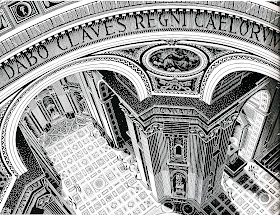 |
| Perhaps the Family Who Lived in the Shoe were enjoying a little juvenile fantasy - with lots of their favorite words. |
In college I majored in linguistics, so it comes as no surprise to anyone that I cherish tender feelings towards many a wonderful word. Perhaps Most Excellent Vocabulary isn't strictly on the topic of juvenile fantasy, let alone block printing, but surely more than a few readers and writers of juvenile fantasy share with me a love of words that goes beyond the mere necessity of stringing together a basic sentence or two. I've decided, therefore, to begin featuring some of these gems each month. In upcoming months I plan to celebrate words according to specific themes or topics, but to start things off this month I thought I'd just present you with a selection of some words that have given me particular delight, and will hopefully please you, too.
floccinaucinihilipilification, n - the act of treating something as if it is of no importance.
Any list of my favorite words has to begin here. When I was eight or nine my mother was given a T-shirt with this word printed on it, and floccinaucinihilipilification has been a friend of the family ever since. When I was teaching middle school I used to amuse my students (during free time, of course) by trying to teach them how to say the word. Much hilarity invariably ensued. (One of my students once said to me with grave respect, "Ms Nydam, you are a person of big words.") This inspired me to let floccinaucinihilipilification take part in a bit more mild hilarity by playing a role in my book The Bad Advice of Grandma Hasenfuss. If it seems implausible to you that knowledge of large, obscure words can help solve an ordinary boy's problems with middle school bullies, then all I can say is that you must never underestimate the magnificent English language. (And maybe you should read the book, too!)
moreover, adv - furthermore, besides.
Of course you know what moreover means. The question is, how often do you use it in conversation? If the answer is "seldom," you really need to give it a little more air time. It is a splendid word, useful in myriad situations. Moreover, it rolls comfortably off the tongue. Try it out today.
divagate, v - to stray off course, to digress, to wander aimlessly.
We all know that sense of listening to a story that goes on longer and longer, wandering off into trackless thickets, circling back in vain attempts to find its path, and eventually giving up in exhaustion far from its original course. I find when listening to such speech it is some small measure of comfort to have a name for it so that I can cry (even if perhaps not aloud), "Will this divagation never end?" But it isn't always bad to divagate. After all, sometimes wonderful adventures await beyond the prescribed track, and, as long as you've packed a decent lunch, great treasure can be found by letting the divagation have its way.
clarity, n - clearness in appearance or thought, lucidity.
I have long considered this word to be one of the most beautiful in the English language. I'm perfectly happy to admit that this judgement is supremely subjective, but to me clarity has a lovely ring of clear consonants and sweet vowels. Moreover, it seems to be just the right sound for its meaning: precise, pure, no muddiness or muddle… I was tempted to name my daughter Clarity, but I didn't think I could talk D into it. (We named her T instead, and of course now it's impossible to imagine her as anything else.)
embrangled, adj (past tense of v) - tangled up, embroiled, ensnarled.
I suppose it's a sad comment on my life that I find such frequent use for this word. I witness committees getting themselves embrangled in disagreements, schedules getting embrangled with too many commitments, children getting embrangled in inside-out sweatshirts, and story ideas getting embrangled as I try to work out plots. I love the way the sound of the word brings to mind something combining a huge snarl of yarn with an avalanche of pots and pans. I also love the connotation of bringing it on myself with my own clumsiness - I imagine tripping over something, reaching out to catch myself and bringing down a shelf-full of teakettles, perhaps, and in my desperate flailing managing to get entirely tangled up in the tea towels before I finally fall over, exhausted, and realize that I am completely embrangled. That's why I almost always use it reflexively: Oh dear. We've gotten ourselves embrangled again.
Obviously five words can't even begin to represent the richness of our language's offerings, but I do hope this short list gets you thinking about the pleasure that words can bring - funny, fancy words and simple, perfect words, alike.


























